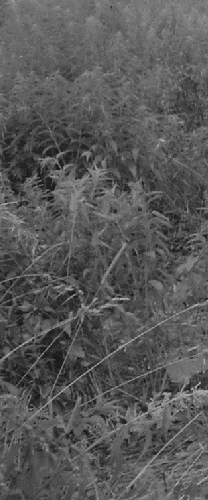Morphology (after Kotov et al., 2010)
Morphology of the cladocerans is quite variable (Figs. 1-5). The body is subdivided into head (Fig. 1: гол), thoracic (Fig. 1: гру), abdominal (Fig. 1: абд) and postabdominal portions (Fig. 1: пос).
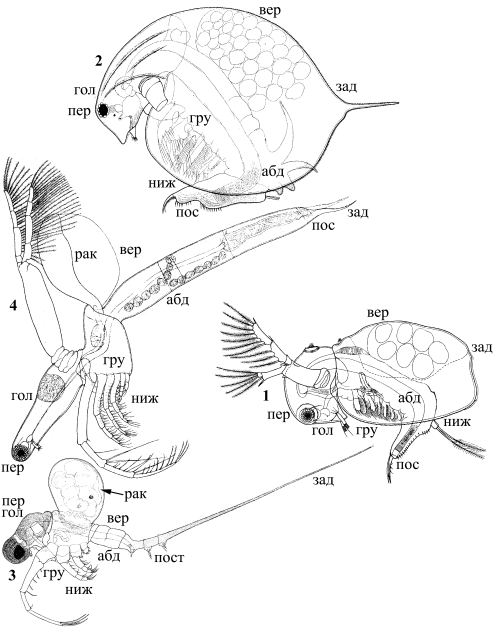 |
| Fig. 1 |
No traces of segmentation are observable in head and thorax. During the description of a cladoceran, we mark its anterior (пер), dorsal (вер), ventral (ниж) and posterior (зад) margin (in laterl view!), and, in the case of well-developed valves, more or less expressed postero-dorsal and postero-ventral angles. The body of the Anomopoda is usually compressed laterally, some species have a dorsal medial keel on valves or(and) on the head. There is a more or less expressed reticulation or even especial sculptre on the body of the majority of the cladocerans (it is usually better observed on valves, Fig. 4: рет).
Hear is usually relatively large, distinctly or unclearly separated from the post-cephalic portion, within the head there are compound eye (Figs. 2-5: слг) and ocellus (гла), in some species one of them or both could be absent. In some anomopods, the head is covered by a head shield (Figs. 3-4: гщи) which is a flattened chitin structure, casting off separately from the valves during the moult. Lateral portions of head shield could cover the base of antennae II, forming paired fornices (Fig. 3: фор).
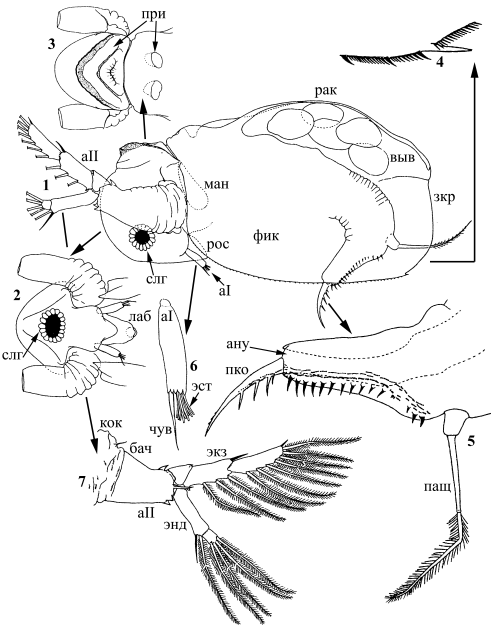 |
| Fig. 2 |
There are ore to many dorsal head pores on the upper side of the head in many cladocerans (Fig. 4: гпо), но у ряда форм они отсутствуют. It is necessary to know, that the term "head pore" is rather conventional, in most cases these are no any holes there, but "windows" of especial cuticle. Among dorsal pores, there are major pores (ггп) of different structure, located exactly on the body and paired lateral pores (лгп). Most cladocerans have a single major pore, but some chydorids have 2-3, and even 4, pores located along the midline, which are located separately or interconnected by some "bridges". Lateral hear pores (if present) are real apertures, they are usually located relatively far from the midline, but in the subfamily Chydorinae they are located almost exactly on the headshield midline. Sida has paired posterior and single anterior anchoring organs (Fig. 2: при).
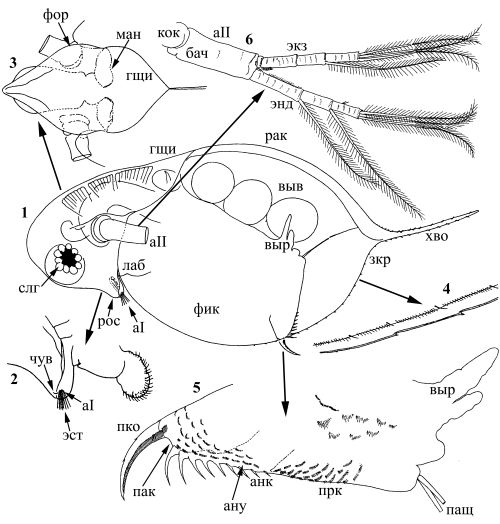 |
| Fig. 3 |
Ventral portion of head is usually suppied by the rostrum (рос) - a projection of different size and shape, having an enterior position, or shifted somewhat porteriorly, antennae I are jointed immediately to the ostrum, or posteriorly to it. Head of a cladoceran, similarly to other crustaceans, have five pairs of the appendages: antenna I or antennules (аI), antennae II or swimming antennae (аII), mandibles (ман), maxilluses (максиллы I-ые) and maxillae (maxillae II), the latter are absent in majority of species in adult state, but always present in embryios. The mouth is covered by the upper lip, named labrum (лаб). The former is supplied in ome groups by a medial keel (Fig. 4: лак) of different shape and, sometims, of a relatively large size.
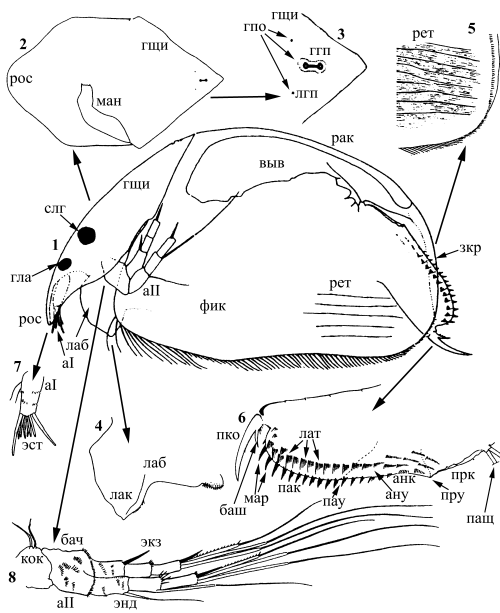 |
| Fig. 4 |
Bivalved shell (carapace) is well-developed in majority of the cladocerans (orders Anomopoda и Ctenopoda) and fully cover the thoracic appendages (Fig.. 1-4: рак). In other cladocerans, (order Onychopoda), it is of medium-size, and do not cover the thoracic appendages (Fig. 5), in Haplopoda (Fig. 1) and some other Onychopoda the carapace is strongly reduced in size.
Many cladocerans have some setae and denticles at free margin of the valve (Fig. 2: 4), in some ctenopods, the valve has a ventral flap. There is a caudal needle on the postero-dorsal angle of some anomopods (Daphnia) (Fig. 3: хво), other anomopods (Scapholeberis, Megafenestra, Bosmina, Bosminopsis) have a projection on the postero-ventral angle - mucro. Armature of the posterior valve margin is pecially important for taxonomy (Fig. 2-4: зкр), there are some setae and setules on the internal face of valve in this region, some cladocerans have some teeth there, or at postero-ventral angle. In Anomopoda and Ctenopoda, their trunc is located within the shell, subdividing the latter into a dorsal brood chamber (Fig. 2-4: выв), where the embryos develop, and a ventral filtering chamber (фик), where the thoracic appendages are located. In Onychopoda and Haplopoda the carapace is served as a brood chamber only (Fig. 1, 5). In the majority of the cladocerans the brood chanber is opened (connected with the environment), but in few taxa (Moinidae, Onychopoda, Penilia) the brood chamber is closed and the embryos here have a feeding support from the mother through its marsupial organ.
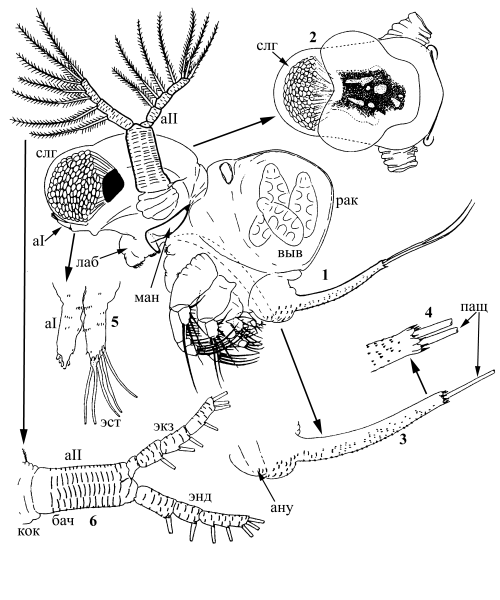 |
| Fig. 5 |
Antenna I could be long or short, in few cases (Bosminidae) its basis is fused with the rostrum. On the body of female antenna I there are a sensory seta (чув), and a bunch of sensorry papillae - aesthetascs (эст). Most cladocerand have 9 aesthetascs. Antenna II ("swimming antenna" is a wrong term, because many benthic and littoral cladocerans use them for other modes of locomotion, not for swimming) consist of a massive protopod (subdividing into a coxal portion (кок) and basal segnent (бач)) and two branches - exopod (external or upper branch) and endopod (internal or lower branch) (Fig. 2-5: экз, энд). The number of segments is varying among different groups from 2 to 4 (Leptodora has a very small fifth segment in the base of endopod). In females of Holopedium, one branch od antenna I is fully absent. Branches are supplied with "swiming" setae, the number of setae on each segment of both branches is described by an "antennal formula", in which the number of setae is marked for each segment from proximal to distal, firstly for exopod, than to endopod, for example, for Sida crystalina it is: 0-3-7/0-1-4 (Fig. 2), for Daphnia cucullata 0-0-1-3/1-1-3 (Fig. 3), for Alona affinis 0-0-3/1-1-3 (Fig. 4). posteriorly to antennae II, there is a pair of mandibles, which are asymmetrical. In majority of the cladocerans they are of triturating type, but predatory forms have tearing mandibles with strong teeth.
There are 4-6 pairs of thoracic appendages., which are very important for the cladoceran taxonomy. There are two types of the thoracic appendages.
The first type is phyllopodous (leaf-like) appendages, which are characterisic of the orders of Ctenopoda and Anomopoda (Fig. 6-8). The term "phyllopodous" is quite conventional. Such appendages are flattend and supplied with two well-developed branches - endopodite (энп) and exopodite (экп), sitting on the protopodite (прп), supplied with epipodite and pre-epipodite on its external face (Fig. 7-8: эпп, пэп), and by a gnatjobase on its internal face (гнт). In the Ctenopoda all thoracic appendages (except of the sixth pair which is stringy simplified) are uniform and supplied with combs of long filtering setae. In Anomopoda each pair of limbs is unique, and filtering combs are present only on III-IV pairs in some representatives, in majority of taxa these combs consist of fewer number of setae and do not use for filtration. The first pair is maximally important for the taxonomy of many anomopods, spcially armature of its inner and outer distal lobes (Fig. 8: 1, 6: вне, вну).
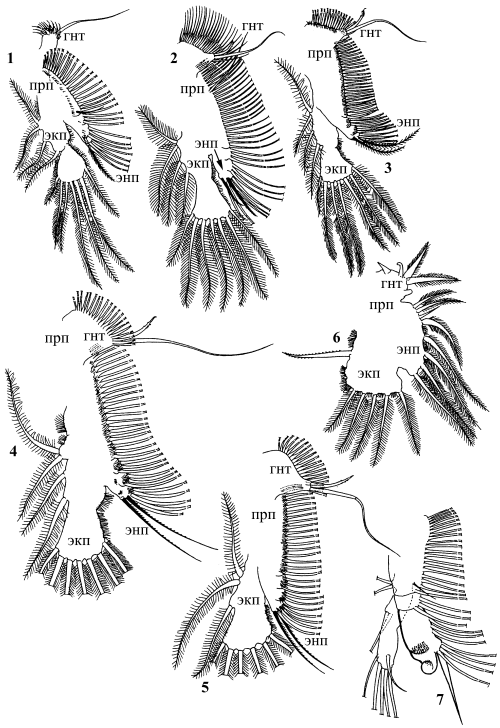 |
| Fig. 6 |
The second type of appendages – segmented – is characteristic of the orders Onychopoda and Haplopoda. Such limbs are cylindrical in section, epipodites and pre-eppodites are absent, exopodites are small or absent. Each limb is supplied by a string spines for catching of the prey (Рис. 9).
In the Anomopoda and Ctenopoda, there is a food groove on the ventral body surface between their limbs through which the filtered food is transported to the nmouth bu beating of the gnathobasic combs, in predatory Onychopoda and Haplopoda, the for groove is absent.
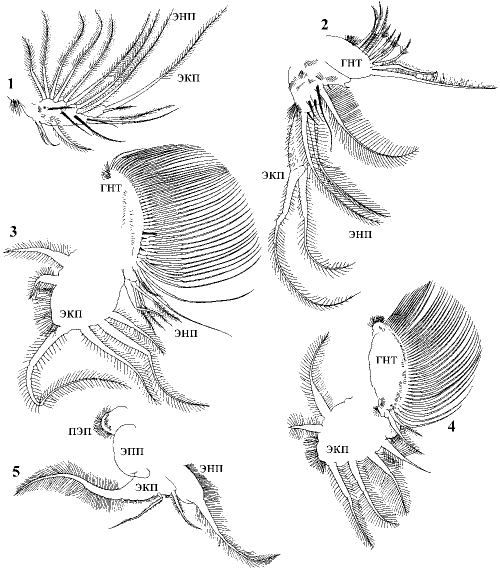 |
| Fig. 7 |
Abdomen is a single body part where some traces of segmentation could be found. It consists of 3-4 segments, and short in the majority of species, while in few representatives (Leptodora, Cercopagidae) is is quite long. In the Anomopoda, one or several abdominal segments are supplied by dorsal abdominal projections (Fig. 3: выр) which prevent the escaping of the eggs from the brood chamber.
The posteriormost body portion is postabdmen, a large, un-segmented portion. In the animal, this body portion is usually bent, and morphologically ventral margin is functionally dorsal one, and vice versa. Anal opening is located distally on the postabdomen or on its dorsal margin, it is necessary to distinguish a preanal (прк), anal (анк) and postanal margin (пак), as well as preanal (Fig. 4: пру) and postanal (пау) angles. Preanal margin is sometimes armed with teeth. Postanal margin has marginal (Fig. 4: мар) and lateral (лат) teeth, debticles or setules. In case when the postabdomen has a well-expressed distal margin, the distal (or postero-dorsal) angle exists.
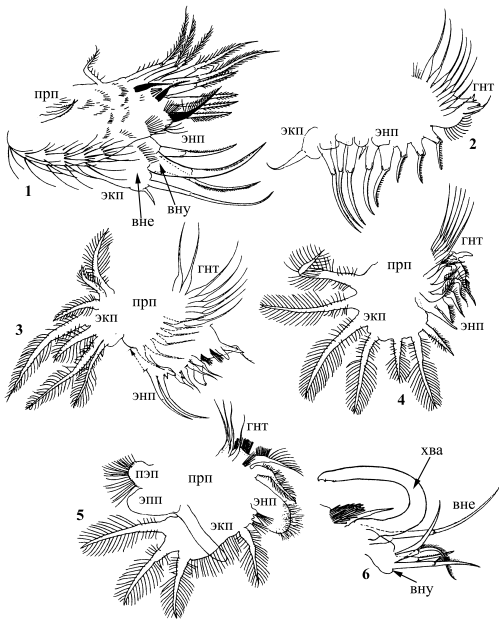 |
| Fig. 8 |
At the base of postabdomen there are paired postabdominal setae (пащ), on its distal end there are postabdominal claws (пко), there is a single basal spine on the base of the latter, or few spines (Fig. 4: баш), dorsal side of claw is armed usually by setules, but sometimes there are series of strong teeth there. In some Onychopoda and Australian Neothrix (Macrothricidae), both postabdomen and postabdominal claws are reduced, and the basis of postabdominal setae has a strong projection, sometimes it is very long.
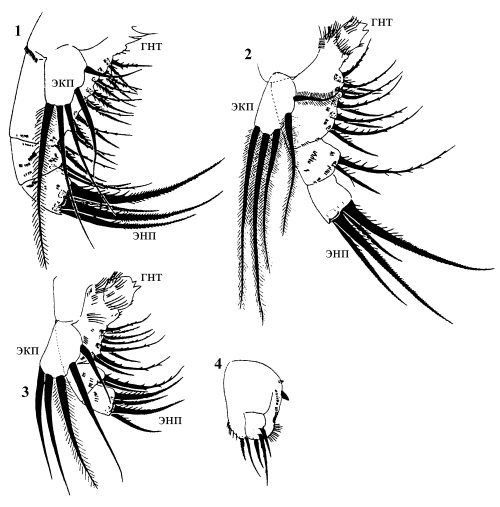 |
| Fig. 9 |
Gamogenetic females do not differ from the parthenogenetic ones in 3 orders, while in the anomopods the dorsal portion of gamogenetic female is modified forming the ephippium (Fig. 10: эфи), containing resting eggs, which are numerous in some cladocerans, while in the chydorids, moinids and macrothricids the ephippium has only 1-2 large eggs.
Males are usually smaller than females, they also have somewgat different body shape, large compound eye, and have no abdominal projections (Fig. 10).
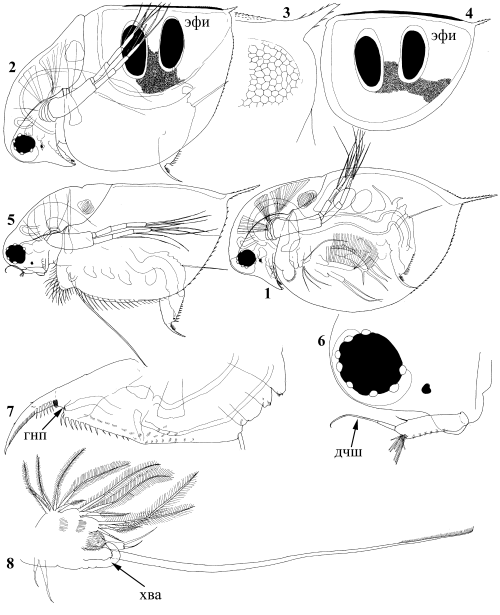 |
| Fig. 10 |
Gonopores (гнп) open in the majority of the anomopods on the postabdomen, which sometimes is modified as compared with the female, in other orders - after the last pair of thoracic limbs. In some ctenopodes paired copulatory appendages are known. Male antennule has an additionsl male sensory seta (дчш), in the daphiids it is specially strong and has especial name - flagellum. Antennules are usually strongly modified in the males which use the former for the female capturing during the copulation. Male limb I in the majority of genera is supplied with a copulatory hook (Fig. 8, 10: хва) on the inner distal lobe, which serves also for female capturing during the copulation. Males are present in the populations only during a short time, and they are unknown for many cladocerans.
